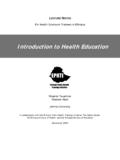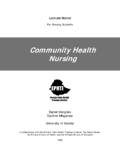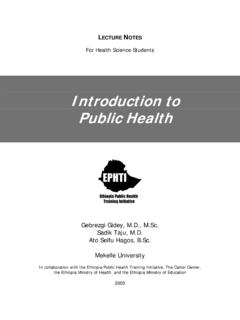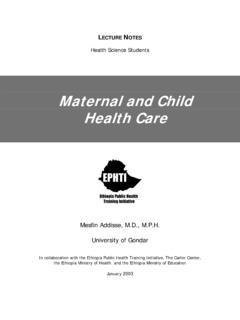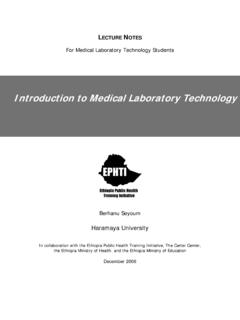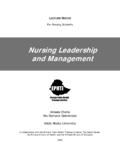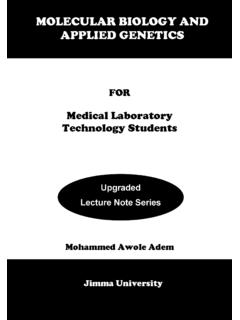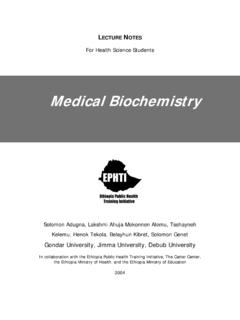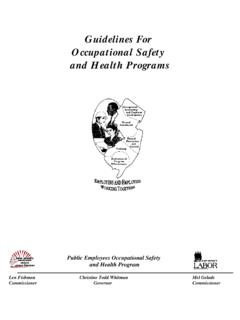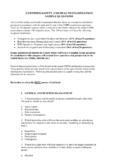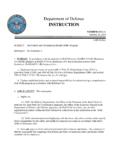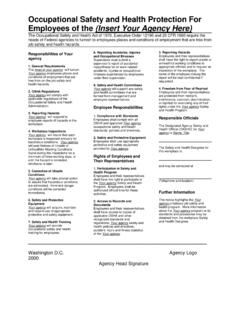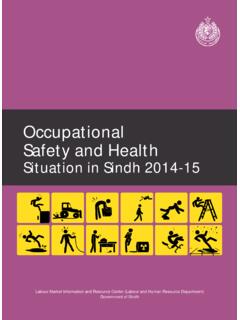Transcription of Occupational Health and Safety - Carter Center
1 LECTURE NOTES For Environmental and Occupational Health Students Occupational Health and Safety Takele Tadesse Mengesha Admassu University of Gondar In collaboration with the Ethiopia Public Health Training Initiative, The Carter Center , the Ethiopia Ministry of Health and, and The Ethiopia Ministry of Education August 2006 Funded under USAID Cooperative Agreement No. 663-A-00-00-0358-00. Produced in collaboration with the Ethiopia Public Health Training Initiative, The Carter Center , the Ethiopia Ministry of Health , and the Ethiopia Ministry of Education. Important Guidelines for Printing and Photocopying Limited permission is granted free of charge to print or photocopy all pages of this publication for educational, not-for-profit use by Health care workers, students or faculty. All copies must retain all author credits and copyright notices included in the original document.
2 Under no circumstances is it permissible to sell or distribute on a commercial basis, or to claim authorship of, copies of material reproduced from this publication. 2006 by Takele Tadesse and Mengesha Admassu All rights reserved. Except as expressly provided above, no part of this publication may be reproduced or transmitted in any form or by any means, electronic or mechanical, including photocopying, recording, or by any information storage and retrieval system, without written permission of the author or authors. This material is intended for educational use only by practicing Health care workers or students and faculty in a Health care field. Occupational Health and Safety 1 CHAPTER ONE Occupational HEATH AND Safety Learning objectives At the end of this chapter, the student will be able to: 1. Define Occupational Health 2. Discuss challenges for the development of Occupational Health and Safety .
3 3. Explain the scope of Occupational Health and Safety . 4. Describe the interrelationship between ooccupational Health and development 5. Identify the elements of a work environment. 6. Discuss the three common interactions in the work place. 7. Explain the interrelationships between work and Health . Introduction Occupational Health and Safety is one of the most important aspects of human concern. It aims an adaptation of working environment to workers for the promotion and maintenance of the highest degree of physical, mental and social well being of workers in all occupations. The question of Occupational Health and Safety , as a global issue, is now taking a new turn. The main contributory factors towards this idiocyncracy seem to be due to the rapid industrial and agricultural development that are taking place in the developing countries, and the emergence of new products and product processes from these Occupational Health and Safety 2places.
4 Many of these countries are moving from manual labour to service mechanization in the main productive sectors, such as manufacturing, mining and agriculture, hence the potential Occupational Health ramifications should be anticipated. Also the insatiable desire of these countries for technical advancement has brought about the importation of sophisticated machinery and pieces of equipment not only into the industrial production sector, but also to services and commerce. This invariably has been associated with a change in the structure of the labour force as a whole including a rise in the employment of women. As to be expected the Health problems would also change. For example, more emphasis on ergonomics and Occupational psychosocial factors would be needed in the services industry. This obviously would be a new challenge for Occupational Health and Safety practice in most of the African countries because the tool to deal with such a problems and the expertise is not yet advanced when compared to the developed countries.
5 The benefit of Occupational Health service in developing countries is seen locally as well as on a national level. The positive impact of Occupational Health service locally may be observed in reducing morbidity and work-related injuries. In addition, this also means fewer losses to employer and worker as there will be a reduction of wage losses and decreased compensation costs. The reduction of absenteeism is of great importance concerning skilled labour, especially so in countries where there is a shortage of skilled labour. Occupational Health and Safety 3 Making working conditions healthy and safe is in the interest of workers, employers and governments, as well as the public at large. Although it seems simple and obvious, this idea has not yet gained meaningful universal recognition. Hundreds of millions of people throughout the world are employed today in conditions that breed ill Health and/or are unsafe.
6 Each year, work-related injuries and diseases kill an estimated 2 million people worldwide, which is greater than the global annual number of deaths from malaria. Annually, an estimated 160 million new cases of work-related diseases occur worldwide, including respiratory and cardiovascular diseases, cancer, hearing loss, musculoskeletal and reproductive disorders, mental and neurological illnesses. An increasing number of workers in industrial countries complain about psychological stress and overwork. These psychological factors have been found to be strongly associated with insomnia, depression and fatigue, and burn-out syndromes, as well as with elevated risks of cardiovascular diseases. Only 5-10% of workers in developing countries and 20-50% of workers in industrial countries (with a few exceptions) are estimated to have access to adequate Occupational Health services.
7 Even in advanced economies, a large proportion of work sites are not regularly inspected for Occupational Health and Safety . Occupational Health and Safety Definition of Terms According to WHO (1995), Occupational Safety and Health can be defined as a multidisciplinary activity aiming at: Protection and promotion of the Health of workers by eliminating Occupational factors and conditions hazardous to Health and Safety at work Enhancement of physical, mental and social well-being of workers and support for the development and maintenance of their working capacity, as well as professional and social development at work Development and promotion of sustainable work environments and work organizations The ILO/WHO definition of Occupational Health is The promotion and maintenance of the highest degree of physical, mental social well- being of workers in all occupation and the WHO considers Occupational Health service to be responsible for the total of worker and, if possible, his or her family.
8 Occupational Health is a diverse science applied by Occupational Health professionals engineers, environmental Health practitioners, chemists, toxicologists, doctors, nurses, Safety professionals and others who have an interest in the protection of the Health of workers in the workplace. Occupational Health and Safety 5 The discipline covers the following key components: 1. the availability of Occupational Health and Safety regulations at workplace 2. the availability of active and functional Occupational Health and Safety committee at workplace 3. monitoring and control of factory hazards to Health 4. supervision and monitoring of hygiene and sanitary facilities for Health and welfare of the workers 5. inspection of Health Safety of protective devices 6. pre-employment, periodical and special Health examination. 7. performance of adaptation of work to man 8.
9 Provision of First Aid 9. Health education and Safety training to the worker 10. Advice to employers on the above mentioned items 11. Reporting of Occupational deaths, diseases, injuries, disabilities ,hazards and their related preventive measures at working According to a statement by Occupational Health institutes collaborating with the WHO (1995) the most important challenges for Occupational Health for the future will be: Occupational Health problems linked to new information technologies and automation; new chemical substances and physical energies; Health hazards associated with new biotechnologies; transfer of hazardous technologies; aging working populations; Occupational Health and Safety 6 special problems of vulnerable and underserved groups ( chronically ill and handicapped), including migrants and the unemployed.
10 And, problems related to growing mobility of worker populations and occurrence of new Occupational diseases of various origins. Interdisciplinary Relationships Environmental Managers: are those trying to eliminate hazards from the workplace cause many environmental problems. Toxicology: is the science that studies poison ands toxic substances and their mechanisms and effects on living organisms. In other words toxicology is the study of adverse effects of chemical on biologic systems, or when a substance has a capacity to produce undesirable physiological effect when the chemical reached a sufficient concentration at a specific site in the body. Toxicologists: are persons who study poisoning and responsible defining quantitatively the level of exposure at which harm occurs and they also prescribe precautionary measures and exposure limitations so that normal recommended use of chemical substance does not result in excessive exposure and subsequent harm Ergonomics: is a multidisciplinary activity dealing with the interaction between man and his total working environment plus such traditional environmental elements as atmosphere, heat, light, and sound as well as all tools and equipment of the work place.
